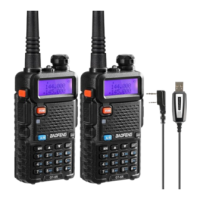
Do you have a question about the Baofeng GT-5R EU Series and is the answer not in the manual?
| Output Power | 5W |
|---|---|
| Battery Capacity | 1800mAh |
| Channel Capacity | 128 channels |
| Antenna | High gain dual band antenna |
| Dimensions | 110 x 58 x 32 mm |
| Operating Voltage | 7.4V DC |
| Antenna Impedance | 50 ohms |
| Frequency Stability | ±2.5ppm |
| Operating Temperature | -20°C to +60°C |
| Waterproof | IP54 |
| Frequency Range | 136-174MHz and 400-520MHz (TX/RX) |
| Channel Spacing | 25KHz/12.5KHz |
EU Regulatory Conformance and RF Exposure Standards compliance.
Guidelines and Operating Instructions for RF exposure control.
Guidelines for transmitting, maintaining distance, and using accessories.
Operating prohibitions and important tips for safe use.
Charging prohibitions and maintenance instructions for batteries.
Information on initial charging, conditioning, and battery life.
Information on using the specified BAOFENG charger.
Warnings and precautions for handling Li-ion batteries.
Step-by-step guide on charging the battery pack.
Explanation of LED indicators during charging status.
Instructions for attaching and detaching the antenna.
Instructions for attaching and detaching the belt clip.
Instructions for installing and removing the battery pack.
Instructions for connecting an external speaker/microphone.
Identification and function of radio buttons and controls.
Explanation of LCD display icons and symbols.
Indicates battery depletion and low voltage warnings.
Description of LED indicator colors for transmitting and receiving.
Detailed functions of each keypad button.
Procedure for turning the radio on and off.
How to increase and decrease the radio's volume.
Steps for initiating calls in channel and frequency modes.
Explanation of VFO and MR modes for channel selection.
How to navigate and enter frequencies in VFO mode.
How to navigate channels in MR mode and switch power levels.
Procedure for scanning frequencies.
Procedure for scanning memory channels.
Scanning for CTCSS tones and DCS codes.
Enabling/disabling Dual Watch and locking transmit channel.
How to use cursor keys for A/B display selection and parameter modification.
How to switch between high and low power.
How to lock and unlock the keypad.
How to turn on/off and scan FM radio stations.
How to turn on, off, and set the flashlight to strobe mode.
How to send tone-bursts using key combinations.
Storing frequencies into memory channels.
Steps to program repeater offset and direction.
Sending DTMF codes using keypad and other keys.
How to navigate menus using arrow keys.
How to access menu items using numerical shortcuts.